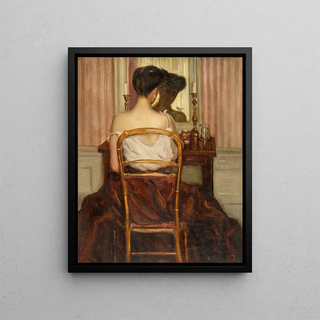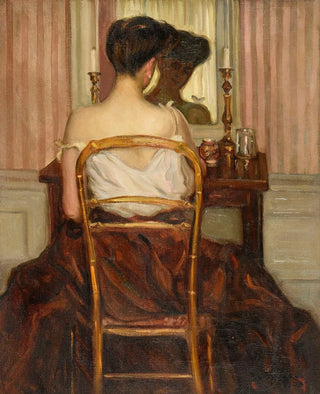Art print | In front of the mirror - Frederick Carl Frieseke


View from behind

Frame (optional)
In the fascinating world of art, some artworks manage to capture the very essence of human intimacy. "Devant la glace" by Frederick Carl Frieseke is one of those creations that evoke an atmosphere both delicate and introspective. This canvas, with its depiction of a woman preparing herself in front of a mirror, invites us to delve into a moment of personal reflection and beauty. The artist, renowned for his mastery of light and color play, succeeds in transforming a mundane scene into a true ode to femininity and serenity. The work belongs to an artistic movement where Impressionism blends with modern sensitivity, making each glance at the canvas unique and moving.
Style and uniqueness of the work
The strength of "Devant la glace" lies in its distinctive style, characterized by a palette of soft colors and subtle lighting that caresses the forms. Frieseke, through his Impressionist approach, manages to capture not only the physical appearance of his model but also the emotion emanating from this moment of contemplation. The fluid and delicate brushstrokes, combined with a harmonious composition, create an almost dreamlike atmosphere. The woman, lost in her thoughts, seems both present and distant, as if she were a reflection of a bygone era where beauty and grace were celebrated at every moment. This artwork transcends a simple portrait to become a reflection on time, beauty, and self-perception, inviting the viewer to question their own relationship with image and identity.
The artist and his influence
Frederick Carl Frieseke, an American painter of German origin, established himself in the art world in the early 20th century. Raised in a rich artistic environment, he was influenced by his stays in France, where he mingled with emblematic figures of Impressionism. His style, although deeply rooted in this tradition, is distinguished by a unique sensitivity to light and color, as well as a capacity to capture moments of everyday life with emotional depth. Frieseke also managed to incorporate elements of emerging modernity into his work, which allowed him

Matte finish

View from behind

Frame (optional)
In the fascinating world of art, some artworks manage to capture the very essence of human intimacy. "Devant la glace" by Frederick Carl Frieseke is one of those creations that evoke an atmosphere both delicate and introspective. This canvas, with its depiction of a woman preparing herself in front of a mirror, invites us to delve into a moment of personal reflection and beauty. The artist, renowned for his mastery of light and color play, succeeds in transforming a mundane scene into a true ode to femininity and serenity. The work belongs to an artistic movement where Impressionism blends with modern sensitivity, making each glance at the canvas unique and moving.
Style and uniqueness of the work
The strength of "Devant la glace" lies in its distinctive style, characterized by a palette of soft colors and subtle lighting that caresses the forms. Frieseke, through his Impressionist approach, manages to capture not only the physical appearance of his model but also the emotion emanating from this moment of contemplation. The fluid and delicate brushstrokes, combined with a harmonious composition, create an almost dreamlike atmosphere. The woman, lost in her thoughts, seems both present and distant, as if she were a reflection of a bygone era where beauty and grace were celebrated at every moment. This artwork transcends a simple portrait to become a reflection on time, beauty, and self-perception, inviting the viewer to question their own relationship with image and identity.
The artist and his influence
Frederick Carl Frieseke, an American painter of German origin, established himself in the art world in the early 20th century. Raised in a rich artistic environment, he was influenced by his stays in France, where he mingled with emblematic figures of Impressionism. His style, although deeply rooted in this tradition, is distinguished by a unique sensitivity to light and color, as well as a capacity to capture moments of everyday life with emotional depth. Frieseke also managed to incorporate elements of emerging modernity into his work, which allowed him






